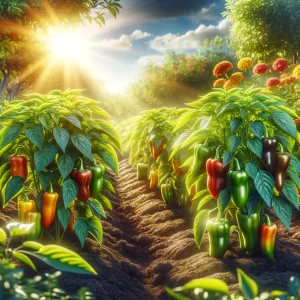
Transplanting pepper seedlings is a critical step in the journey of growing peppers, whether you’re a hobbyist gardener or a commercial grower. The process can significantly impact the health, growth, and yield of your pepper plants. With the rising interest in home gardening and sustainable living, understanding when to transplant seedlings and the right way to transplant pepper seedlings has never been more relevant. This guide will walk you through the process step by step, ensuring your pepper plants thrive in their new environment.
When to Transplant Pepper Seedlings
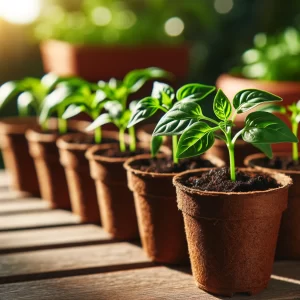
Timing is everything when it comes to transplanting pepper seedlings. The ideal time is after the last frost when the soil has warmed up to at least 60°F (15°C), typically in late spring or early summer. Pepper plants are warm-season crops that thrive in warm temperatures, and transplanting them too early can stunt their growth or even be fatal.
Wait until your seedlings produce their third set of true leaves, which indicates they are strong enough to handle the transition. Usually, that occurs about 3 to 4 weeks after sprouting, though the exact timeline can vary. This timing also aligns with the growing interest in seasonal gardening, making it especially relevant for those looking to optimize their gardening efforts.
Preparing the New Home
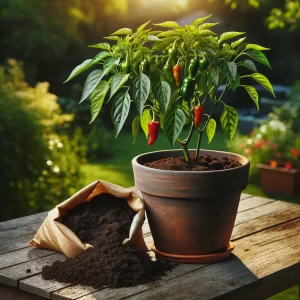
Before you transplant, it’s essential to prepare the new location, whether it’s in your garden bed or a larger container. Ensure the soil is rich in organic matter and well-draining to promote healthy root growth. Amend the soil with compost or a balanced, slow-release fertilizer to provide essential nutrients. The pH of the soil should ideally be between 6.0 and 6.8.
If you’re planting in containers, choose ones that are at least 12 inches deep to accommodate the pepper plants’ root system. This preparation is crucial for the plants’ success and aligns with the trend towards organic and sustainable gardening practices.
Acclimatizing Your Seedlings
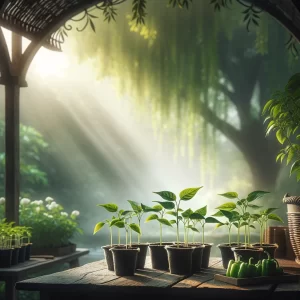
Acclimatization, or “hardening off,” is a process that gradually introduces indoor-grown seedlings to outdoor conditions. Over 7 to 10 days, start by placing your seedlings outside in a shaded, sheltered area for a few hours each day, gradually increasing their exposure to sunlight and outdoor temperatures. This step is vital for reducing transplant shock, a common issue that can stunt growth and affect the overall health of the plants. With the increasing popularity of starting seeds indoors, this step has become more relevant for gardeners looking to transition their plants outdoors successfully.
The Transplanting Process
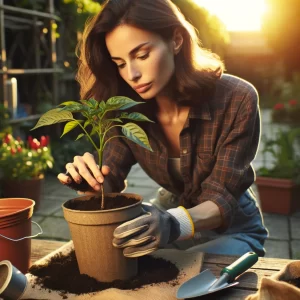
When it’s time to transplant, water your seedlings thoroughly a few hours before moving them; this makes the soil cling to the roots and reduces stress on the plant. Dig a hole in the prepared soil slightly larger than the seedling’s root ball. Gently remove the seedling from its current container, being careful not to damage the roots. Then, roll the root ball gently to loosen it up and ensure the pepper plant isn’t rootbound. After that, carefully place it in the hole.
The base of the stem should be level with the soil surface. Backfill the hole with soil and press lightly to remove air pockets, then water the seedling gently but thoroughly to help settle the soil around the roots. This process is crucial for ensuring a smooth transition and promoting strong root development.
Post-Transplant Care
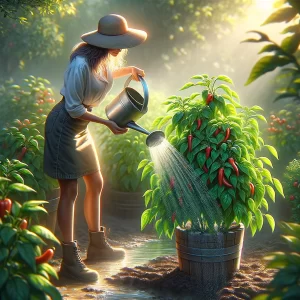
After transplanting, it’s essential to provide your pepper plants with consistent care to ensure they thrive. Keep the soil evenly moist, but avoid overwatering, which can lead to root rot. Mulching around the base of the plants can help retain soil moisture and regulate temperature. Provide support with stakes or cages as the plants grow, especially for larger varieties that can become top-heavy with peppers.
Regular feeding with a balanced fertilizer can also promote healthy growth and fruit production. This ongoing care is essential for maximizing the yield and health of your pepper plants, reflecting the broader trend toward meticulous and informed gardening practices.
Congratulations! You’ve Transplant Pepper Seedlings Successfully!
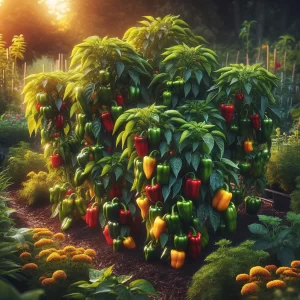
Transplanting pepper seedlings successfully is a key step in growing healthy and productive plants. By following this step-by-step guide, gardeners can ensure their pepper plants are well-prepared to thrive in their new environment. The process, from choosing the right time to post-transplant care, reflects current trends in gardening towards sustainability, organic practices, and the joy of growing your food. With patience and attention to detail, you can enjoy a bountiful harvest of peppers from your garden.
Catherine is a tech-savvy writer who has focused on the personal finance space for more than eight years. She has a Bachelor’s in Information Technology and enjoys showcasing how tech can simplify everyday personal finance tasks like budgeting, spending tracking, and planning for the future. Additionally, she’s explored the ins and outs of the world of side hustles and loves to share what she’s learned along the way. When she’s not working, you can find her relaxing at home in the Pacific Northwest with her two cats or enjoying a cup of coffee at her neighborhood cafe.
Leave a Reply